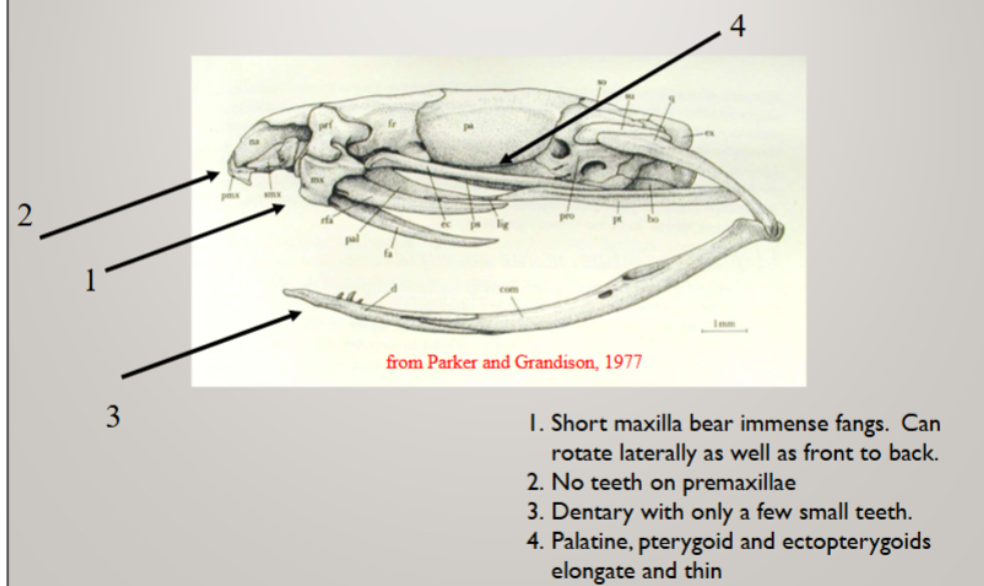reptiles lecture
1/39
There's no tags or description
Looks like no tags are added yet.
Name | Mastery | Learn | Test | Matching | Spaced |
|---|
No study sessions yet.
40 Terms
Lepidosauria Synapomorphies
transverse cloacal slit
tongue notched distally
breakage planes in tail (CAUDAL AUTONOMY)
ecdysis (skin shedding) synchronous
Subclass Lepidosauria (taxonomy)
order Sphenodontida- Tuatara (1 species)
order Squamata (12, 194 species)
suborder Lacertilla (Sauria)- lizards
suborder Amphosbaenia- worm lizards (nested within lizards)
suborder Serpentes (Opidia)- snakes (nested within lizards)
order Rhynchocephalia (Tuataras of New Zealand)
family Spenodontidae
1 genus, 2 species
New Zealand
fully diapsid skull
gastralia
acrodont dentition
no intromittant organ
low metabolic rate and slow growth
known as fossils from Cretaceous
order Squamata Synapomorphies
paired copulatory organ (hemipenes)
egg tooth
limb reduction (multiple origins), 3 major clades exhibit it
6 major Squamate clades
Gekkota
Dibamidae
Schincoidea
Anguimorpha
Lacertoidea
Iguania
what 2 clades of squamates branches off early in history?
Gekkota and Dibamidae
Gekkota
7 families
>100 genera, 2252 species
found almost worldwide, but absent in some temperate areas
most have lizard like body but one family (Pygopotidae) contains snake like species
all carnivorous, few supplement w nectar
most nocturnal, few diurnal
many arborea, several terrestrial, rock dwellers, or burrowing
range in size ~30 m to ~500 mm, include some of worlds smallest lizards (Sphaerodactylus)
probably sister group to all other squamates, along w Dibamidae
have many derived and unusual characteristics
most active only at night (nocturnal) which has many impacts on other aspects like their lack of bright coloration, most communicate vocally
most other lizards diurnal and active during heat of day and brightly colored
“gecko” comes from sound made by one species from SE Asia (Tokay gecko, Gekko gecko)
vocalization consists of barks, chirps, and clicks
most have large eyes (captures more light) w vertical, slit like pupils
most lack moveable eyelids
clean eye using tongue
unusual in that they have clutch sizes of only 1-2 eggs, whereas other lizards have many more (20 -40 in some)
many thrive alongside humans and are found alongside fluorescent lights outside houses at night
therefore are most introduced geckoes in US found in SoFlo (has 10+ introduced, 1 native species)
Mediterranean gecko, Hemidactylus turcicus is most widespread introduced gecko in US from southern Europe
Gecko toes
most arboreal (living in trees) and have toe pads that let them climb on almost anything
feet have lamella, lamellae have setae, setae have spatula (smaller bristles)
setae (1/10 diameter human hair) and cling through intermolecular forces (Van der Walls)
angle is critical in forming and breaking bonds
Dibamidae
snake like, short tailed burrowers
males have tiny external limbs, females legless
2 genera, 1 genus w 1 species (Anelytropsis) in NE Mexico
other genus (Dibamus) has 24 species in SE Asia
Iguanidae
48 genera, 1260 species
12 families
new world, galapagos, fiji, madagascar
visually oriented and diurnal, some arboreal
herbivores, insectivores, carnivores
simple tongue prehensile
box like skull w lateral temporal arch
pleurodont tooth attachment
external pineal eye
Iguania- Agamidae
64 genera, 567 species, 6 subfamilies
warmer parts of old world
simple tongue- prehensile (capable of grasping)
visually oriented and diurnal
arboreal or terrestrial
box like skull w lateral temporal arch
external pineal eye
acrodont tooth attachment
osteoderms absent
limbs never reduced
draco: elongated, highly mobile ribs support thin membrane of skin- used for gliding flight
Iguania- Chamaeleonidae
12 genera, 222 species
africa, madagascar, arabia, india
boxlike skull w bony casque, acrodont teeth
large eyes w small pupils move independently
zygodactylus feet, mostly arboreal
laterally compressed body
tail usually prehensile
projectile tongue, insectivores
change color
Scincoidea- Cordylidae
some species heavily armored
armadillo girdled lizard (Ouroborus cataphractus) bites tail and makes itself into ball when attacked
evolution of limb reduced and snake like forms in africa
Scincoidea- Scincidae
common name among “skinks”`
1 of largest families of lizards along w geckoes (>159 genera, 1741 species)
found all over the world
typically small, diurnal, terrestrial, carnivorous
some giant herbivores like Corucia zebrata (prehensile- tailed skink) from Solomon Islands
about 45% species lie bearing (viviparous)
almost all have round, shiny, overlapping scales underlain by bones called “osteoderms)
have reduced limbs and snake like body
most of ~20 origins of short tailed snake like burrowing ecomorph are within skinks
Australia has incredible diversity of skinks including giant blue tongues skink which includes shingleback
Lacertoidea- Teiidae
9 genera, 125+ species
found in N, middle, and S America and W Indes
small to relatively large
pleurodont dentition
most species active, diurnal, heat loving, terrestrial, and carnivorous
Tegus- giant South American teiids, look like monitor lizards
1/3 of 47 Aspidocelis species are all female parthenogenetic species
all female whiptails
all female species formed through hybridization of bisexual species (similar to ambystomatid salamanders)
all female species typically diploid (produce unreduced, 2N eggs)
in some cases diploid parthenogen will mate w bisexual species and form new triploid parthenogenetic species
these species not more successful bc deleterious mutations accumulate in asexual lineages- '“Muller’s Ratchet” and sexual reproduction keeps deleterious mutations at low frequency and produces novel gene combinations
Lacertoidea- Lacertidae
25 genera, ±250 species
body covered w small granular scales and large, square or rectangualr ventral
usually w osteoderms (bony plates or scales under skin) under head scales
several parthenogenic forms known
pleurodent dentition
old world
Lacertoidea- Amphisbaenia
small, usually legless burrowers
no external ear openings
eyes covered w skin
few large teeth, eat insects, grubs, worms, termites, etc
africa, SW Asia, central and S america
1 eastern US species, Rhineura floridana
Anguimorpha- Anguidae
glass lizards, alligator lizards, and relatives
glass lizard (Ophisaurus)- long tailed grass swimmer found in NA, europe, asia
all other anguid genera restricted to new world
mostly terrestrial, diurnal, carnivores
many viviparous species
coolest alligator lizard: genus Abronia, live in bromeliads in cloud forests in Mexico and Guatemala
Anguimorpha- Helodermatidae
1 genus (Heloderma), 5 species
considered only dangerously venomous lizards
Gila Monster (Heloderma suspectum)- southwestern US and N Mexico in deseets
mexican beaded lizard (Heloderma horridum)- found from NW mexico to guatemala, in dry tropical forests
Anguimorpha- Varanidae
monitor lizards
1 genus (Varanus), 83 species
asia, africa, australia (most species)
includes worlds largest living lizard (komodo dragon, Varanus komodoensis)
most terrestrial, some arboreal and semi squatic
carnivorous, may eat relatively large prey, few species eat fruit
have some development of venom
Serpentes synapomorphies
pectoral girdle absent
pelvic girdle absent or rudimentary
body elongated by adding vertebrae (usually 120-240)
5 points of articulation in vertebrae
left lung absent or reduced, right lung dominant
genetic sex determination
no external ear or tympanum but can hear vibrations
carnivorous
Serpentes teeth categories
aglyphous- non venemous species, no specialized teeth
solenoglyphs- movable hollow fangs located on front of maxllae; vipers, pit vipers
proteroglyphs- grooved fangs partially or completely closed over; fixed on front of maxillae- elapids (including hydrophiids)
opisthoglyphs- posterior pair of teeth, on maxilla enlarged, usually grooved, aid in passage of venom but often ineffective, rear fanged colubrids (Heloderma)
solenoglyphs
movable hollow fangs located on front of maxllae; vipers, pit vipers
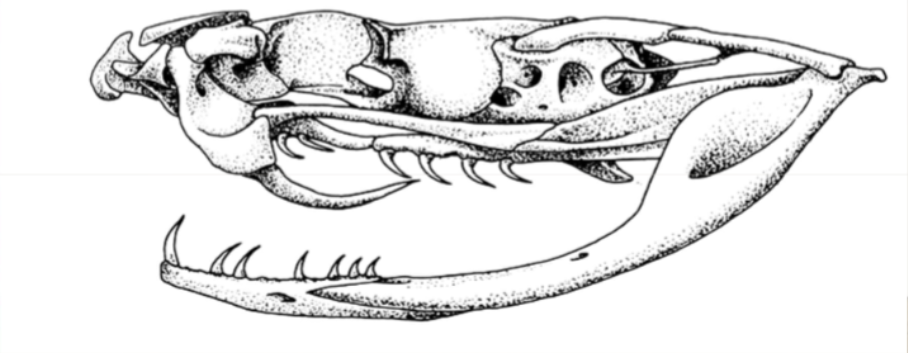
proteroglyphs
grooved fangs partially or completely closed over; fixed on front of maxillaee
elapids (including hydrophiids): family of snakes characterized by their permanently erect fangs at the front of the mouth
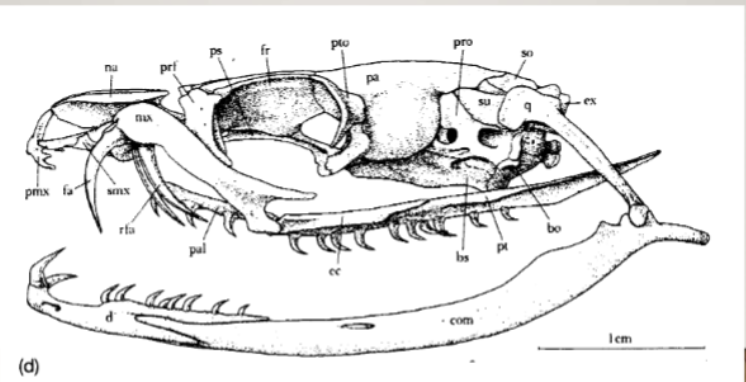
opisthoglyphs
posterior pair of teeth, on maxilla enlarged, usually grooved, aid in passage of venom but often ineffective, rear fanged colubrids (Heloderma)
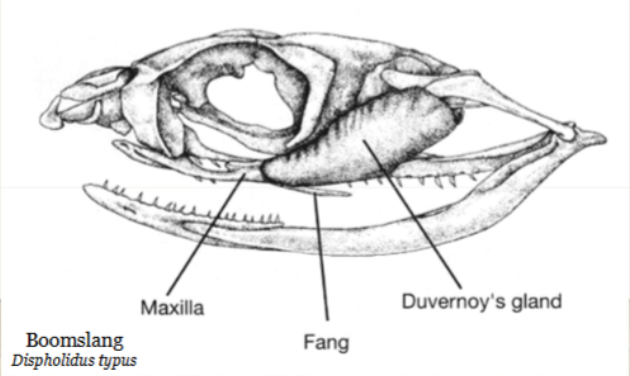
aglyphous
non venemous species, no specialized teeth
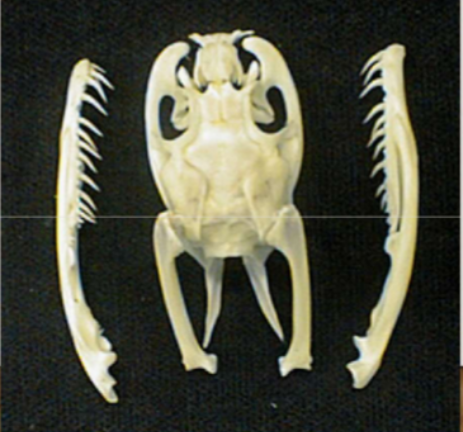
venoms
elapid: neurotoxins
viperid: hemolytic and cytolytic, except neurotoxins in some populations of 10 rattlesnake species
`hemolytic: can cause the destruction of red blood cells (hemolysis), leading to various complications, including anemia
process of cell destruction or lysis, occurs when cells are damaged or killed, leading to their breakdown and release of their contents
colubrid venoms???
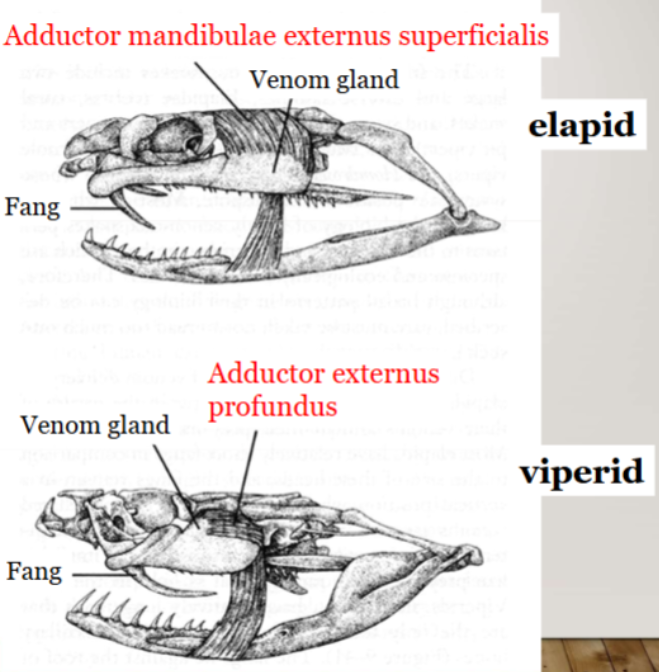
Scolecophidia- blind snakes
Typhlopidae
Leptotyphlopidae
Anomalepidae
Typhlopidae
6 genera, 200 species
central america and s america
maxilla arranged transversely w teeth
body covered w overlapping shiny scales
eyes covered w scales but visible
ventral scales not enlarged
premaxillae without teeth
dentaries without teeth
oviparous (producing young by means of eggs that are hatched after they have been laid by the parent)
Alethinophidia- normal snakes
about 15 family level groups
more basal groups
Boidae (Boinae, Erycinae, Charininae, …)
Pythonidae
Boidae
14 genera, 67 species, 7 subfamilies
new world, central and E africa, middle east, oceania, madagascar
no teeth on premaxillae
maxillae oriented longitudinally w teeth
dentary (the anterior bone of the lower jaw) w teeth
viviparous (bringing forth live young that have developed inside the body of the parent) except 1 or 2 burrowing forms
limb and girdle vestiges and spurs present
both oviducts well developed
Boinae
premaxillae without teeth
relatively massive involvement of frontal in jaw support
coronoid
jaw relatively mobile
elaborate vomeronasal organ and vomer bones
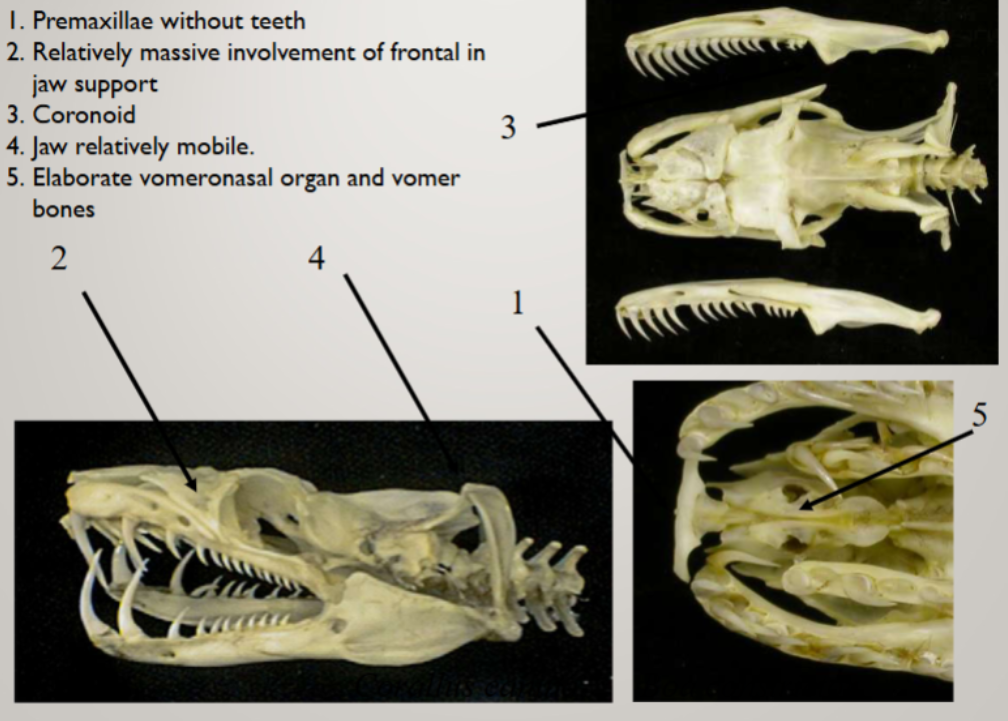
Pythonidae
11 genera, 38 species
warmer parts of old world, australia
teeth on premaxillae
maxillae oriented longitudinally w teeth
dentary w teeth
oviparous and most females attend nests
limb and girdle vestiges and spurs present
both oviducts well developed
labial pits- infrared detectors
jaw suspension intermediate between aniliids and caenophidians
coronoid
limb vestiges present in musculature
spurs extend to exterior as spurs (claws), usually larger in males
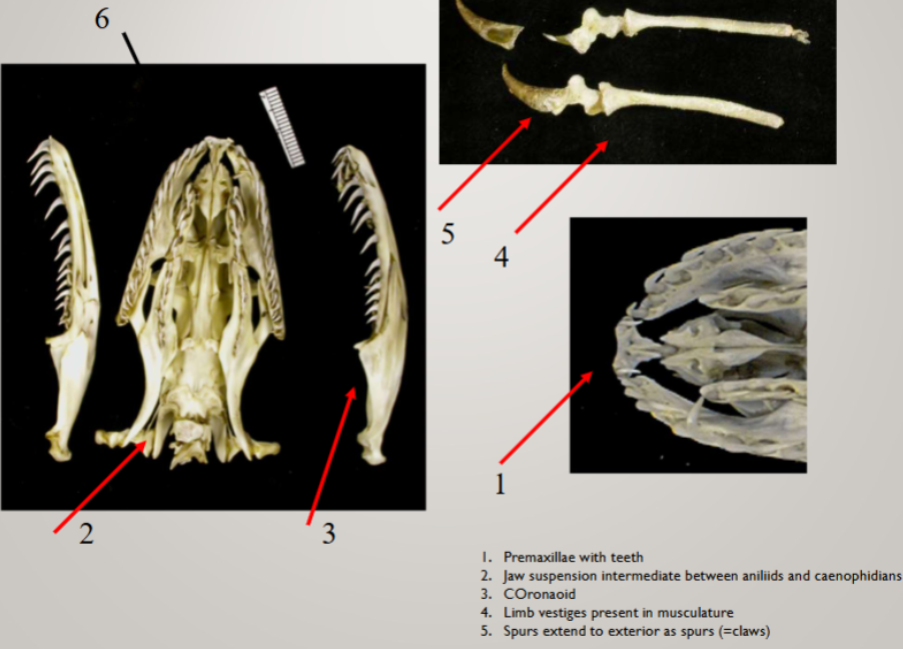
modern groups
viperidae
colubridae
elapidae
atractaspidae
Viperidae
41 genera, over 386 species, 3 subfamilies
worldwide except australia, antarctica, madagascar, and some islands
no teeth on premaxillae
solenoglyphs- blocklike maxillae carry tubular fangs and rotate forwards for envenomation
hind limb vestiges absent
both oviducts well developed
oviparous and viviparous lineages
small to moderately large size
Colubridae
>211 genera, 2093 species, 8 subfamilies
52% of all snakes
cosmopolitan
hind limb vestiges absent
no teeth on premaxillae
maxillae aglyphous, opithoglyphous, or proteroglyphous
both oviducts well developed
oviparous and viviparous forms
small to moderate size
upper jaws very loosely attaches to braincase, highly mobile
maxillae without fangs or w enlarged grooved teeth or anterior fangs
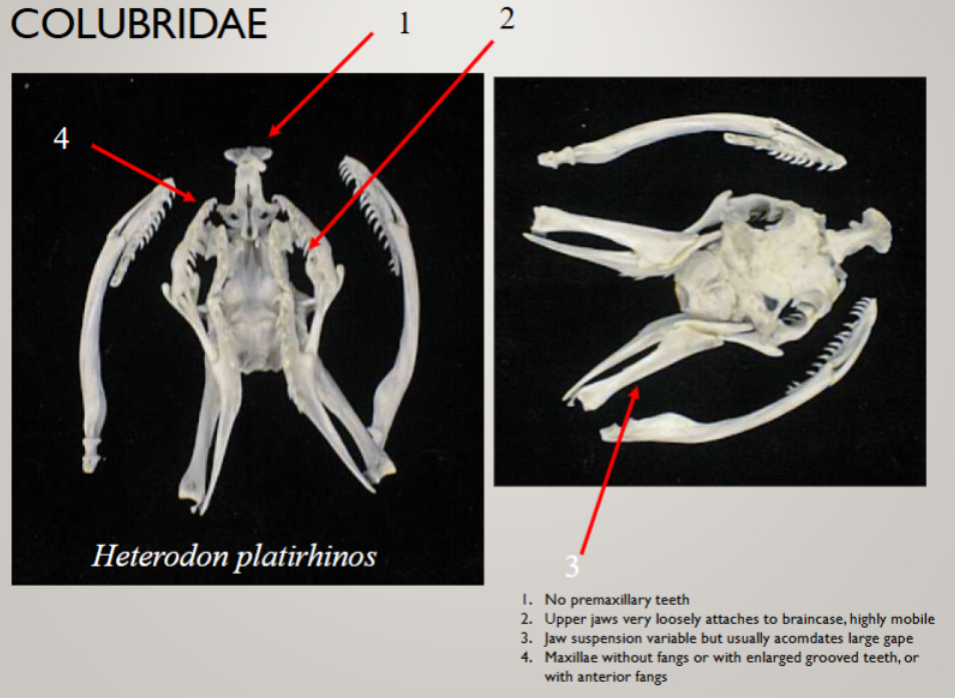
Elapidae
54 genera, 398 species, 2 subfamilies
warmer, wetter parts of world
no teeth on premaxillae
all venomous, most relatively harmless to humans
maxillae w anterior, erect, grooved, or hollow fangs
hind limb vestiges absent
both oviducts well developed
oviparous (eggs hatched after being laid) or viviparous (develop inside body of parent)
small to large in size
sea snakes and kraits (marine elapids)
sea snakes: 9 genera in Hydrophiinae
sea kraits Laticauda- in Elapinae
venemous
adaptations to marine enviro include: flattened paddle like tails, lung longer than other snakes, valved nostrils, sublingual salt glands, skin more impermeable to salt
Atractaspidae
13 genera, over 57 species, 2 subfamilies
sub saharan africa and coastal arabia
no teeth of premaxillae
hind limb vestiges absent
small to large fangs, which are semi erect
left lung absent or vestigial, tracheal lung present or absent
some dangerously venomous species
both oviducts well developed
oviparous and viviparous forms
small to moderate size
short and rotatable maxilla bears very long hollow fangs, rest of jaw suspension very thinly built
head indistinct from body, venom glands elongate and may extend well onto body
tail short
